Florian Bernard
Hyper Diffusion Avatars: Dynamic Human Avatar Generation using Network Weight Space Diffusion
Sep 04, 2025Abstract:Creating human avatars is a highly desirable yet challenging task. Recent advancements in radiance field rendering have achieved unprecedented photorealism and real-time performance for personalized dynamic human avatars. However, these approaches are typically limited to person-specific rendering models trained on multi-view video data for a single individual, limiting their ability to generalize across different identities. On the other hand, generative approaches leveraging prior knowledge from pre-trained 2D diffusion models can produce cartoonish, static human avatars, which are animated through simple skeleton-based articulation. Therefore, the avatars generated by these methods suffer from lower rendering quality compared to person-specific rendering methods and fail to capture pose-dependent deformations such as cloth wrinkles. In this paper, we propose a novel approach that unites the strengths of person-specific rendering and diffusion-based generative modeling to enable dynamic human avatar generation with both high photorealism and realistic pose-dependent deformations. Our method follows a two-stage pipeline: first, we optimize a set of person-specific UNets, with each network representing a dynamic human avatar that captures intricate pose-dependent deformations. In the second stage, we train a hyper diffusion model over the optimized network weights. During inference, our method generates network weights for real-time, controllable rendering of dynamic human avatars. Using a large-scale, cross-identity, multi-view video dataset, we demonstrate that our approach outperforms state-of-the-art human avatar generation methods.
Symmetry Understanding of 3D Shapes via Chirality Disentanglement
Aug 07, 2025Abstract:Chirality information (i.e. information that allows distinguishing left from right) is ubiquitous for various data modes in computer vision, including images, videos, point clouds, and meshes. While chirality has been extensively studied in the image domain, its exploration in shape analysis (such as point clouds and meshes) remains underdeveloped. Although many shape vertex descriptors have shown appealing properties (e.g. robustness to rigid-body transformations), they are often not able to disambiguate between left and right symmetric parts. Considering the ubiquity of chirality information in different shape analysis problems and the lack of chirality-aware features within current shape descriptors, developing a chirality feature extractor becomes necessary and urgent. Based on the recent Diff3F framework, we propose an unsupervised chirality feature extraction pipeline to decorate shape vertices with chirality-aware information, extracted from 2D foundation models. We evaluated the extracted chirality features through quantitative and qualitative experiments across diverse datasets. Results from downstream tasks including left-right disentanglement, shape matching, and part segmentation demonstrate their effectiveness and practical utility. Project page: https://wei-kang-wang.github.io/chirality/
TwoSquared: 4D Generation from 2D Image Pairs
Apr 17, 2025Abstract:Despite the astonishing progress in generative AI, 4D dynamic object generation remains an open challenge. With limited high-quality training data and heavy computing requirements, the combination of hallucinating unseen geometry together with unseen movement poses great challenges to generative models. In this work, we propose TwoSquared as a method to obtain a 4D physically plausible sequence starting from only two 2D RGB images corresponding to the beginning and end of the action. Instead of directly solving the 4D generation problem, TwoSquared decomposes the problem into two steps: 1) an image-to-3D module generation based on the existing generative model trained on high-quality 3D assets, and 2) a physically inspired deformation module to predict intermediate movements. To this end, our method does not require templates or object-class-specific prior knowledge and can take in-the-wild images as input. In our experiments, we demonstrate that TwoSquared is capable of producing texture-consistent and geometry-consistent 4D sequences only given 2D images.
Fast Globally Optimal and Geometrically Consistent 3D Shape Matching
Apr 10, 2025Abstract:Geometric consistency, i.e. the preservation of neighbourhoods, is a natural and strong prior in 3D shape matching. Geometrically consistent matchings are crucial for many downstream applications, such as texture transfer or statistical shape modelling. Yet, in practice, geometric consistency is often overlooked, or only achieved under severely limiting assumptions (e.g. a good initialisation). In this work, we propose a novel formalism for computing globally optimal and geometrically consistent matchings between 3D shapes which is scalable in practice. Our key idea is to represent the surface of the source shape as a collection of cyclic paths, which are then consistently matched to the target shape. Mathematically, we construct a hyper product graph (between source and target shape), and then cast 3D shape matching as a minimum-cost circulation flow problem in this hyper graph, which yields global geometrically consistent matchings between both shapes. We empirically show that our formalism is efficiently solvable and that it leads to high-quality results.
4Deform: Neural Surface Deformation for Robust Shape Interpolation
Feb 27, 2025Abstract:Generating realistic intermediate shapes between non-rigidly deformed shapes is a challenging task in computer vision, especially with unstructured data (e.g., point clouds) where temporal consistency across frames is lacking, and topologies are changing. Most interpolation methods are designed for structured data (i.e., meshes) and do not apply to real-world point clouds. In contrast, our approach, 4Deform, leverages neural implicit representation (NIR) to enable free topology changing shape deformation. Unlike previous mesh-based methods that learn vertex-based deformation fields, our method learns a continuous velocity field in Euclidean space. Thus, it is suitable for less structured data such as point clouds. Additionally, our method does not require intermediate-shape supervision during training; instead, we incorporate physical and geometrical constraints to regularize the velocity field. We reconstruct intermediate surfaces using a modified level-set equation, directly linking our NIR with the velocity field. Experiments show that our method significantly outperforms previous NIR approaches across various scenarios (e.g., noisy, partial, topology-changing, non-isometric shapes) and, for the first time, enables new applications like 4D Kinect sequence upsampling and real-world high-resolution mesh deformation.
Implicit Neural Surface Deformation with Explicit Velocity Fields
Jan 23, 2025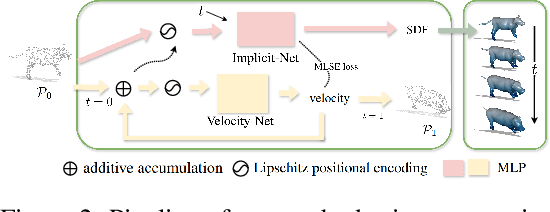


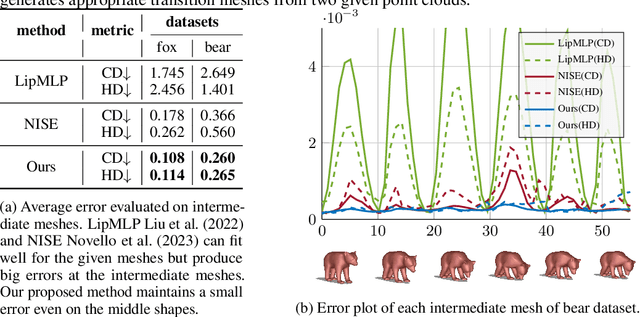
Abstract:In this work, we introduce the first unsupervised method that simultaneously predicts time-varying neural implicit surfaces and deformations between pairs of point clouds. We propose to model the point movement using an explicit velocity field and directly deform a time-varying implicit field using the modified level-set equation. This equation utilizes an iso-surface evolution with Eikonal constraints in a compact formulation, ensuring the integrity of the signed distance field. By applying a smooth, volume-preserving constraint to the velocity field, our method successfully recovers physically plausible intermediate shapes. Our method is able to handle both rigid and non-rigid deformations without any intermediate shape supervision. Our experimental results demonstrate that our method significantly outperforms existing works, delivering superior results in both quality and efficiency.
Beyond Complete Shapes: A quantitative Evaluation of 3D Shape Matching Algorithms
Nov 05, 2024

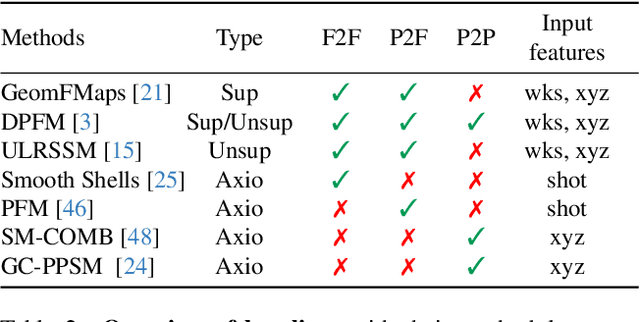
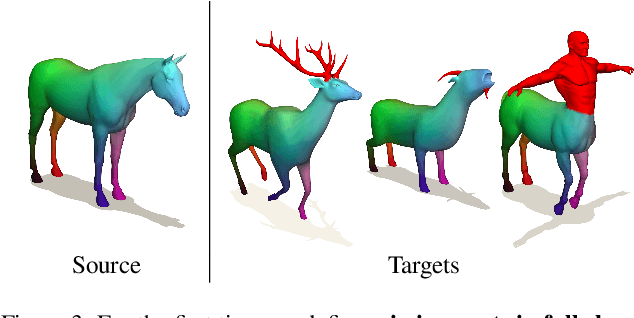
Abstract:Finding correspondences between 3D shapes is an important and long-standing problem in computer vision, graphics and beyond. While approaches based on machine learning dominate modern 3D shape matching, almost all existing (learning-based) methods require that at least one of the involved shapes is complete. In contrast, the most challenging and arguably most practically relevant setting of matching partially observed shapes, is currently underexplored. One important factor is that existing datasets contain only a small number of shapes (typically below 100), which are unable to serve data-hungry machine learning approaches, particularly in the unsupervised regime. In addition, the type of partiality present in existing datasets is often artificial and far from realistic. To address these limitations and to encourage research on these relevant settings, we provide a generic and flexible framework for the procedural generation of challenging partial shape matching scenarios. Our framework allows for a virtually infinite generation of partial shape matching instances from a finite set of shapes with complete geometry. Further, we manually create cross-dataset correspondences between seven existing (complete geometry) shape matching datasets, leading to a total of 2543 shapes. Based on this, we propose several challenging partial benchmark settings, for which we evaluate respective state-of-the-art methods as baselines.
Synchronous Diffusion for Unsupervised Smooth Non-Rigid 3D Shape Matching
Jul 11, 2024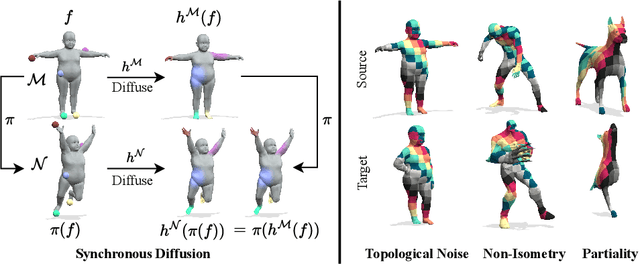



Abstract:Most recent unsupervised non-rigid 3D shape matching methods are based on the functional map framework due to its efficiency and superior performance. Nevertheless, respective methods struggle to obtain spatially smooth pointwise correspondences due to the lack of proper regularisation. In this work, inspired by the success of message passing on graphs, we propose a synchronous diffusion process which we use as regularisation to achieve smoothness in non-rigid 3D shape matching problems. The intuition of synchronous diffusion is that diffusing the same input function on two different shapes results in consistent outputs. Using different challenging datasets, we demonstrate that our novel regularisation can substantially improve the state-of-the-art in shape matching, especially in the presence of topological noise.
Unlocking the Potential of Operations Research for Multi-Graph Matching
Jun 26, 2024Abstract:We consider the incomplete multi-graph matching problem, which is a generalization of the NP-hard quadratic assignment problem for matching multiple finite sets. Multi-graph matching plays a central role in computer vision, e.g., for matching images or shapes, so that a number of dedicated optimization techniques have been proposed. While the closely related NP-hard multi-dimensional assignment problem (MDAP) has been studied for decades in the operations research community, it only considers complete matchings and has a different cost structure. We bridge this gap and transfer well-known approximation algorithms for the MDAP to incomplete multi-graph matching. To this end, we revisit respective algorithms, adapt them to incomplete multi-graph matching, and propose their extended and parallelized versions. Our experimental validation shows that our new method substantially outperforms the previous state of the art in terms of objective and runtime. Our algorithm matches, for example, 29 images with more than 500 keypoints each in less than two minutes, whereas the fastest considered competitor requires at least half an hour while producing far worse results.
$C^2M^3$: Cycle-Consistent Multi-Model Merging
May 28, 2024


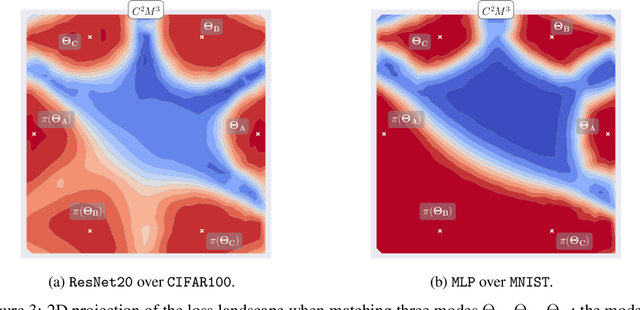
Abstract:In this paper, we present a novel data-free method for merging neural networks in weight space. Differently from most existing works, our method optimizes for the permutations of network neurons globally across all layers. This allows us to enforce cycle consistency of the permutations when merging $N \geq 3$ models, allowing circular compositions of permutations to be computed without accumulating error along the path. We qualitatively and quantitatively motivate the need for such a constraint, showing its benefits when merging sets of models in scenarios spanning varying architectures and datasets. We finally show that, when coupled with activation renormalization, our approach yields the best results in the task.
 Add to Chrome
Add to Chrome Add to Firefox
Add to Firefox Add to Edge
Add to Edge